Financial Resource Management and Decisions: Clariton Antiques Report
VerifiedAdded on 2020/01/28
|15
|4232
|98
Report
AI Summary
This report provides a detailed financial analysis of Clariton Antiques Limited, examining various aspects of financial resource management and decision-making. It begins by exploring different sources of finance, including internal and external options for both incorporated and unincorporated businesses, with a specific focus on Clariton Antiques' potential funding strategies for expansion. The report then delves into financial planning, including budgeting, the implications of financial inadequacy, and the risks associated with overtrading. It assesses the decisions made by partners, venture capitalists, and finance brokers, highlighting their roles in evaluating the company's financial health. Furthermore, the report analyzes the impact of financial statements on stakeholders, such as venture capitalists and finance brokers, and conducts a cash budget analysis to evaluate the company's cash flow management. Unit cost calculations and a review of investment techniques applied are also included. Finally, the report examines financial ratios, comparing different components and interpreting their significance for the company's financial performance.
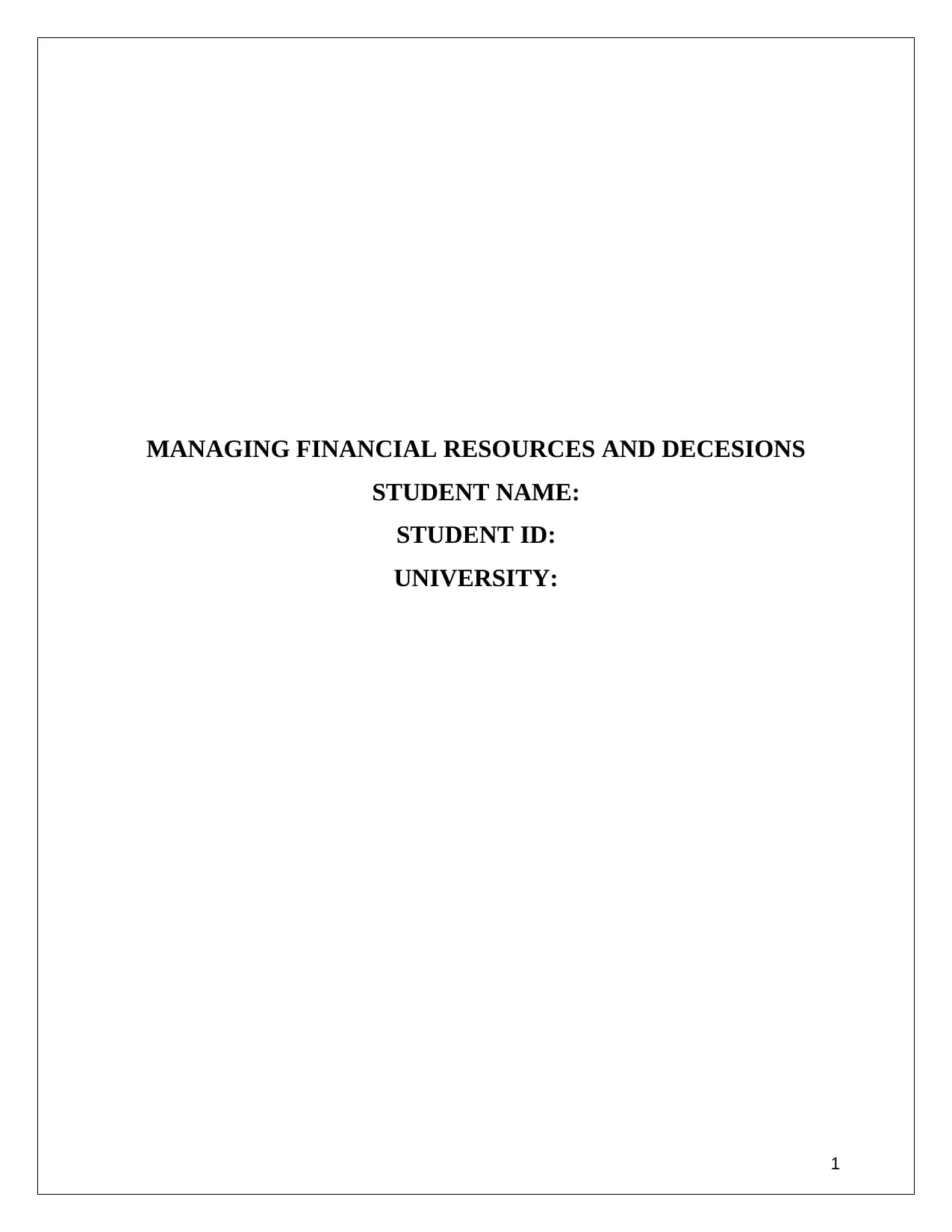
MANAGING FINANCIAL RESOURCES AND DECESIONS
STUDENT NAME:
STUDENT ID:
UNIVERSITY:
1
STUDENT NAME:
STUDENT ID:
UNIVERSITY:
1
Paraphrase This Document
Need a fresh take? Get an instant paraphrase of this document with our AI Paraphraser
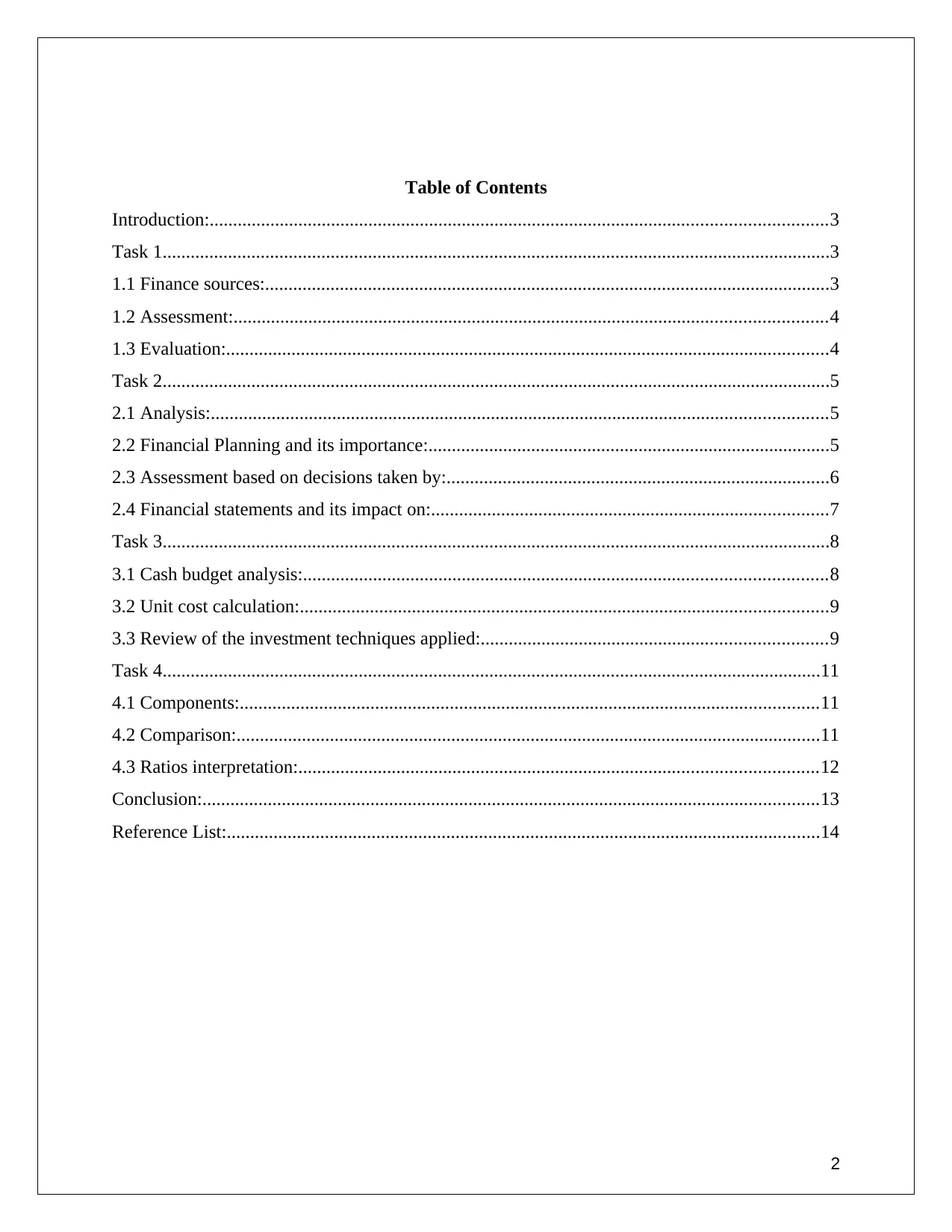
Table of Contents
Introduction:....................................................................................................................................3
Task 1...............................................................................................................................................3
1.1 Finance sources:.........................................................................................................................3
1.2 Assessment:...............................................................................................................................4
1.3 Evaluation:.................................................................................................................................4
Task 2...............................................................................................................................................5
2.1 Analysis:....................................................................................................................................5
2.2 Financial Planning and its importance:......................................................................................5
2.3 Assessment based on decisions taken by:..................................................................................6
2.4 Financial statements and its impact on:.....................................................................................7
Task 3...............................................................................................................................................8
3.1 Cash budget analysis:................................................................................................................8
3.2 Unit cost calculation:.................................................................................................................9
3.3 Review of the investment techniques applied:..........................................................................9
Task 4.............................................................................................................................................11
4.1 Components:............................................................................................................................11
4.2 Comparison:.............................................................................................................................11
4.3 Ratios interpretation:...............................................................................................................12
Conclusion:....................................................................................................................................13
Reference List:...............................................................................................................................14
2
Introduction:....................................................................................................................................3
Task 1...............................................................................................................................................3
1.1 Finance sources:.........................................................................................................................3
1.2 Assessment:...............................................................................................................................4
1.3 Evaluation:.................................................................................................................................4
Task 2...............................................................................................................................................5
2.1 Analysis:....................................................................................................................................5
2.2 Financial Planning and its importance:......................................................................................5
2.3 Assessment based on decisions taken by:..................................................................................6
2.4 Financial statements and its impact on:.....................................................................................7
Task 3...............................................................................................................................................8
3.1 Cash budget analysis:................................................................................................................8
3.2 Unit cost calculation:.................................................................................................................9
3.3 Review of the investment techniques applied:..........................................................................9
Task 4.............................................................................................................................................11
4.1 Components:............................................................................................................................11
4.2 Comparison:.............................................................................................................................11
4.3 Ratios interpretation:...............................................................................................................12
Conclusion:....................................................................................................................................13
Reference List:...............................................................................................................................14
2
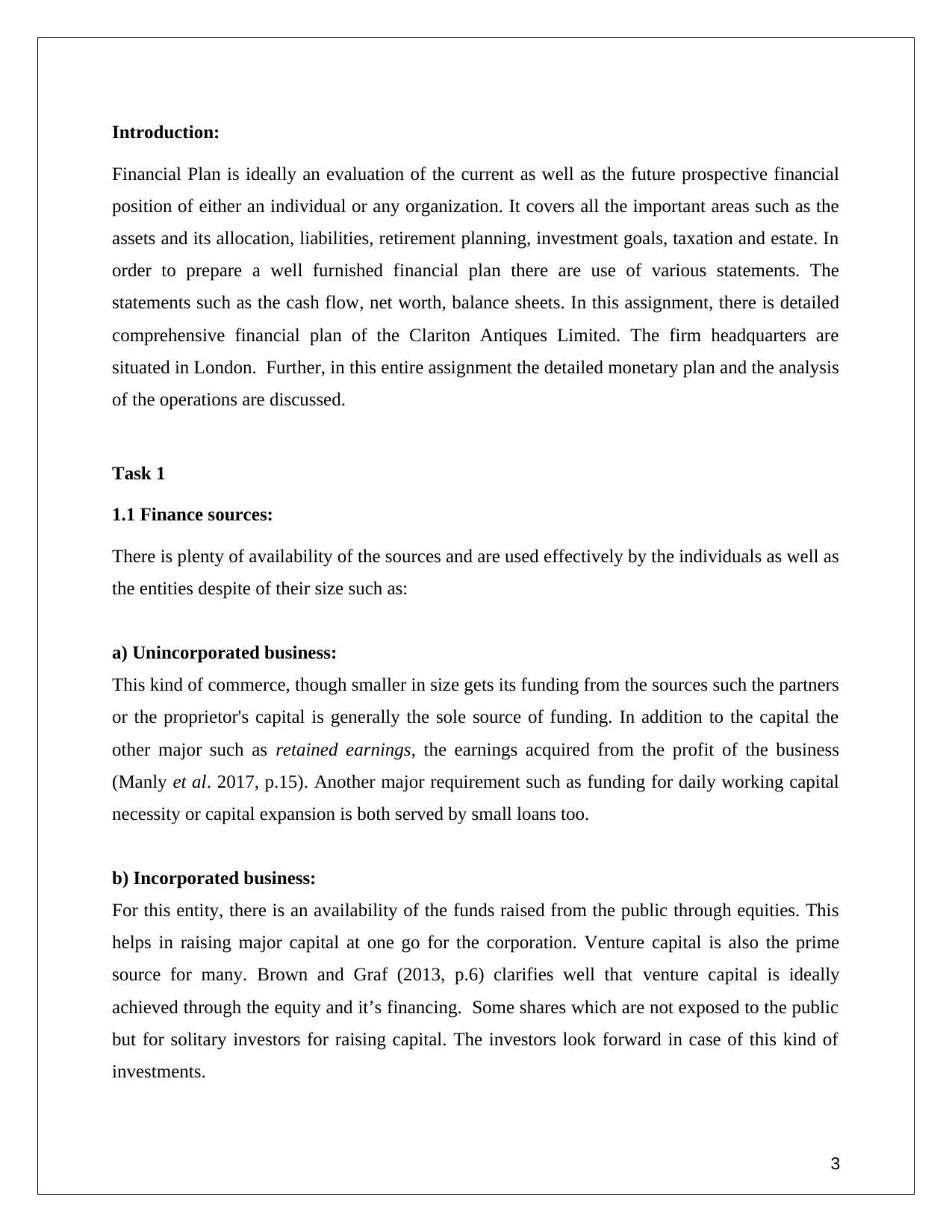
Introduction:
Financial Plan is ideally an evaluation of the current as well as the future prospective financial
position of either an individual or any organization. It covers all the important areas such as the
assets and its allocation, liabilities, retirement planning, investment goals, taxation and estate. In
order to prepare a well furnished financial plan there are use of various statements. The
statements such as the cash flow, net worth, balance sheets. In this assignment, there is detailed
comprehensive financial plan of the Clariton Antiques Limited. The firm headquarters are
situated in London. Further, in this entire assignment the detailed monetary plan and the analysis
of the operations are discussed.
Task 1
1.1 Finance sources:
There is plenty of availability of the sources and are used effectively by the individuals as well as
the entities despite of their size such as:
a) Unincorporated business:
This kind of commerce, though smaller in size gets its funding from the sources such the partners
or the proprietor's capital is generally the sole source of funding. In addition to the capital the
other major such as retained earnings, the earnings acquired from the profit of the business
(Manly et al. 2017, p.15). Another major requirement such as funding for daily working capital
necessity or capital expansion is both served by small loans too.
b) Incorporated business:
For this entity, there is an availability of the funds raised from the public through equities. This
helps in raising major capital at one go for the corporation. Venture capital is also the prime
source for many. Brown and Graf (2013, p.6) clarifies well that venture capital is ideally
achieved through the equity and it’s financing. Some shares which are not exposed to the public
but for solitary investors for raising capital. The investors look forward in case of this kind of
investments.
3
Financial Plan is ideally an evaluation of the current as well as the future prospective financial
position of either an individual or any organization. It covers all the important areas such as the
assets and its allocation, liabilities, retirement planning, investment goals, taxation and estate. In
order to prepare a well furnished financial plan there are use of various statements. The
statements such as the cash flow, net worth, balance sheets. In this assignment, there is detailed
comprehensive financial plan of the Clariton Antiques Limited. The firm headquarters are
situated in London. Further, in this entire assignment the detailed monetary plan and the analysis
of the operations are discussed.
Task 1
1.1 Finance sources:
There is plenty of availability of the sources and are used effectively by the individuals as well as
the entities despite of their size such as:
a) Unincorporated business:
This kind of commerce, though smaller in size gets its funding from the sources such the partners
or the proprietor's capital is generally the sole source of funding. In addition to the capital the
other major such as retained earnings, the earnings acquired from the profit of the business
(Manly et al. 2017, p.15). Another major requirement such as funding for daily working capital
necessity or capital expansion is both served by small loans too.
b) Incorporated business:
For this entity, there is an availability of the funds raised from the public through equities. This
helps in raising major capital at one go for the corporation. Venture capital is also the prime
source for many. Brown and Graf (2013, p.6) clarifies well that venture capital is ideally
achieved through the equity and it’s financing. Some shares which are not exposed to the public
but for solitary investors for raising capital. The investors look forward in case of this kind of
investments.
3
⊘ This is a preview!⊘
Do you want full access?
Subscribe today to unlock all pages.

Trusted by 1+ million students worldwide
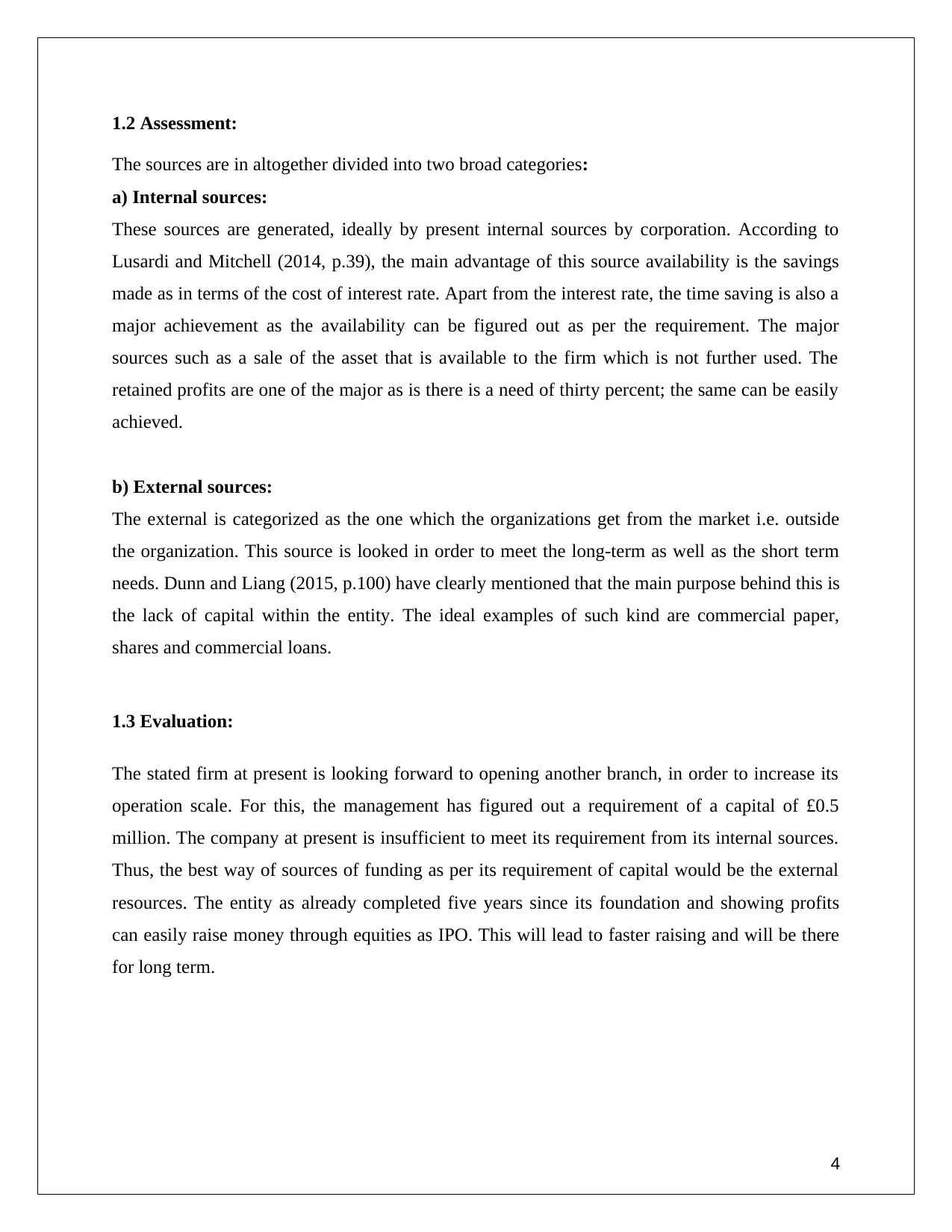
1.2 Assessment:
The sources are in altogether divided into two broad categories:
a) Internal sources:
These sources are generated, ideally by present internal sources by corporation. According to
Lusardi and Mitchell (2014, p.39), the main advantage of this source availability is the savings
made as in terms of the cost of interest rate. Apart from the interest rate, the time saving is also a
major achievement as the availability can be figured out as per the requirement. The major
sources such as a sale of the asset that is available to the firm which is not further used. The
retained profits are one of the major as is there is a need of thirty percent; the same can be easily
achieved.
b) External sources:
The external is categorized as the one which the organizations get from the market i.e. outside
the organization. This source is looked in order to meet the long-term as well as the short term
needs. Dunn and Liang (2015, p.100) have clearly mentioned that the main purpose behind this is
the lack of capital within the entity. The ideal examples of such kind are commercial paper,
shares and commercial loans.
1.3 Evaluation:
The stated firm at present is looking forward to opening another branch, in order to increase its
operation scale. For this, the management has figured out a requirement of a capital of £0.5
million. The company at present is insufficient to meet its requirement from its internal sources.
Thus, the best way of sources of funding as per its requirement of capital would be the external
resources. The entity as already completed five years since its foundation and showing profits
can easily raise money through equities as IPO. This will lead to faster raising and will be there
for long term.
4
The sources are in altogether divided into two broad categories:
a) Internal sources:
These sources are generated, ideally by present internal sources by corporation. According to
Lusardi and Mitchell (2014, p.39), the main advantage of this source availability is the savings
made as in terms of the cost of interest rate. Apart from the interest rate, the time saving is also a
major achievement as the availability can be figured out as per the requirement. The major
sources such as a sale of the asset that is available to the firm which is not further used. The
retained profits are one of the major as is there is a need of thirty percent; the same can be easily
achieved.
b) External sources:
The external is categorized as the one which the organizations get from the market i.e. outside
the organization. This source is looked in order to meet the long-term as well as the short term
needs. Dunn and Liang (2015, p.100) have clearly mentioned that the main purpose behind this is
the lack of capital within the entity. The ideal examples of such kind are commercial paper,
shares and commercial loans.
1.3 Evaluation:
The stated firm at present is looking forward to opening another branch, in order to increase its
operation scale. For this, the management has figured out a requirement of a capital of £0.5
million. The company at present is insufficient to meet its requirement from its internal sources.
Thus, the best way of sources of funding as per its requirement of capital would be the external
resources. The entity as already completed five years since its foundation and showing profits
can easily raise money through equities as IPO. This will lead to faster raising and will be there
for long term.
4
Paraphrase This Document
Need a fresh take? Get an instant paraphrase of this document with our AI Paraphraser
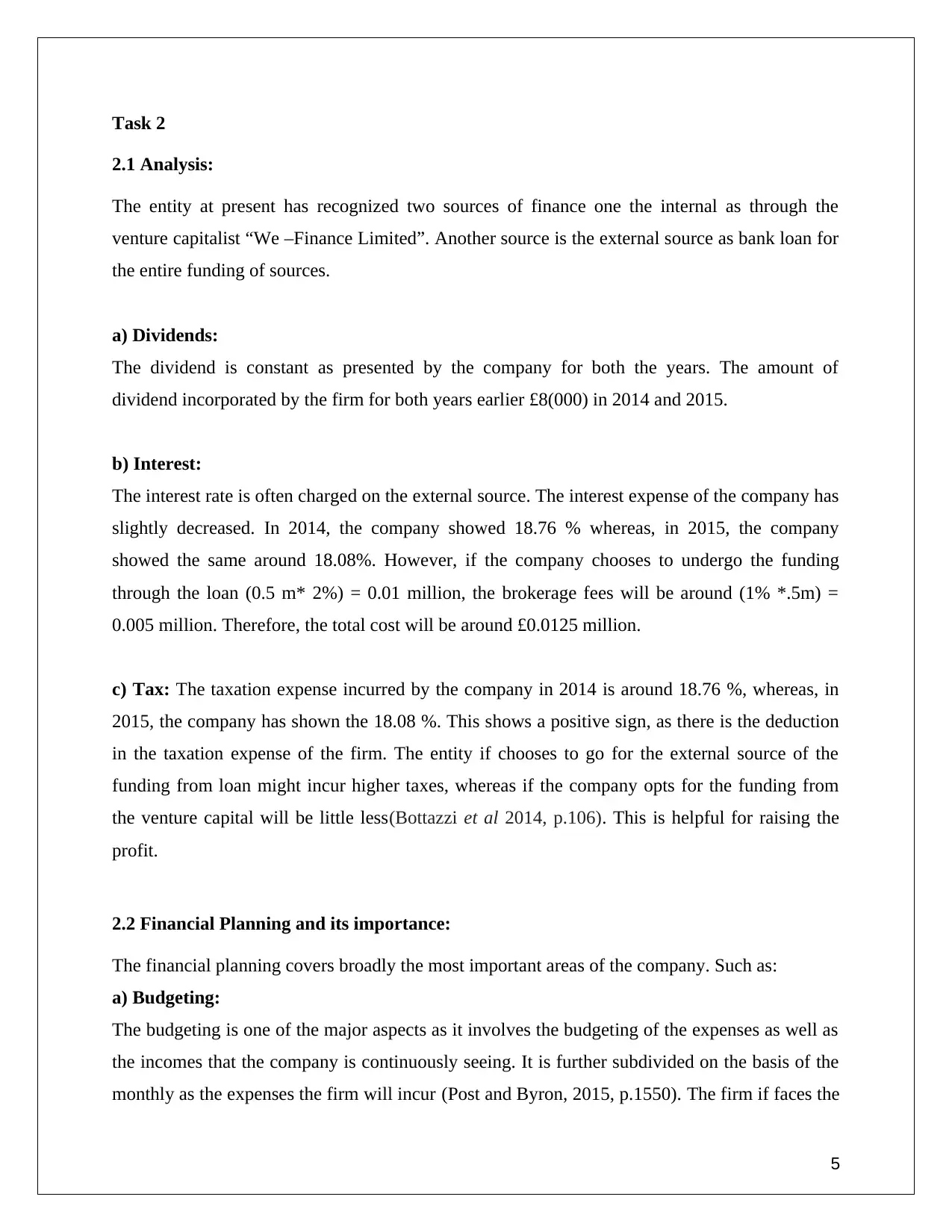
Task 2
2.1 Analysis:
The entity at present has recognized two sources of finance one the internal as through the
venture capitalist “We –Finance Limited”. Another source is the external source as bank loan for
the entire funding of sources.
a) Dividends:
The dividend is constant as presented by the company for both the years. The amount of
dividend incorporated by the firm for both years earlier £8(000) in 2014 and 2015.
b) Interest:
The interest rate is often charged on the external source. The interest expense of the company has
slightly decreased. In 2014, the company showed 18.76 % whereas, in 2015, the company
showed the same around 18.08%. However, if the company chooses to undergo the funding
through the loan (0.5 m* 2%) = 0.01 million, the brokerage fees will be around (1% *.5m) =
0.005 million. Therefore, the total cost will be around £0.0125 million.
c) Tax: The taxation expense incurred by the company in 2014 is around 18.76 %, whereas, in
2015, the company has shown the 18.08 %. This shows a positive sign, as there is the deduction
in the taxation expense of the firm. The entity if chooses to go for the external source of the
funding from loan might incur higher taxes, whereas if the company opts for the funding from
the venture capital will be little less(Bottazzi et al 2014, p.106). This is helpful for raising the
profit.
2.2 Financial Planning and its importance:
The financial planning covers broadly the most important areas of the company. Such as:
a) Budgeting:
The budgeting is one of the major aspects as it involves the budgeting of the expenses as well as
the incomes that the company is continuously seeing. It is further subdivided on the basis of the
monthly as the expenses the firm will incur (Post and Byron, 2015, p.1550). The firm if faces the
5
2.1 Analysis:
The entity at present has recognized two sources of finance one the internal as through the
venture capitalist “We –Finance Limited”. Another source is the external source as bank loan for
the entire funding of sources.
a) Dividends:
The dividend is constant as presented by the company for both the years. The amount of
dividend incorporated by the firm for both years earlier £8(000) in 2014 and 2015.
b) Interest:
The interest rate is often charged on the external source. The interest expense of the company has
slightly decreased. In 2014, the company showed 18.76 % whereas, in 2015, the company
showed the same around 18.08%. However, if the company chooses to undergo the funding
through the loan (0.5 m* 2%) = 0.01 million, the brokerage fees will be around (1% *.5m) =
0.005 million. Therefore, the total cost will be around £0.0125 million.
c) Tax: The taxation expense incurred by the company in 2014 is around 18.76 %, whereas, in
2015, the company has shown the 18.08 %. This shows a positive sign, as there is the deduction
in the taxation expense of the firm. The entity if chooses to go for the external source of the
funding from loan might incur higher taxes, whereas if the company opts for the funding from
the venture capital will be little less(Bottazzi et al 2014, p.106). This is helpful for raising the
profit.
2.2 Financial Planning and its importance:
The financial planning covers broadly the most important areas of the company. Such as:
a) Budgeting:
The budgeting is one of the major aspects as it involves the budgeting of the expenses as well as
the incomes that the company is continuously seeing. It is further subdivided on the basis of the
monthly as the expenses the firm will incur (Post and Byron, 2015, p.1550). The firm if faces the
5
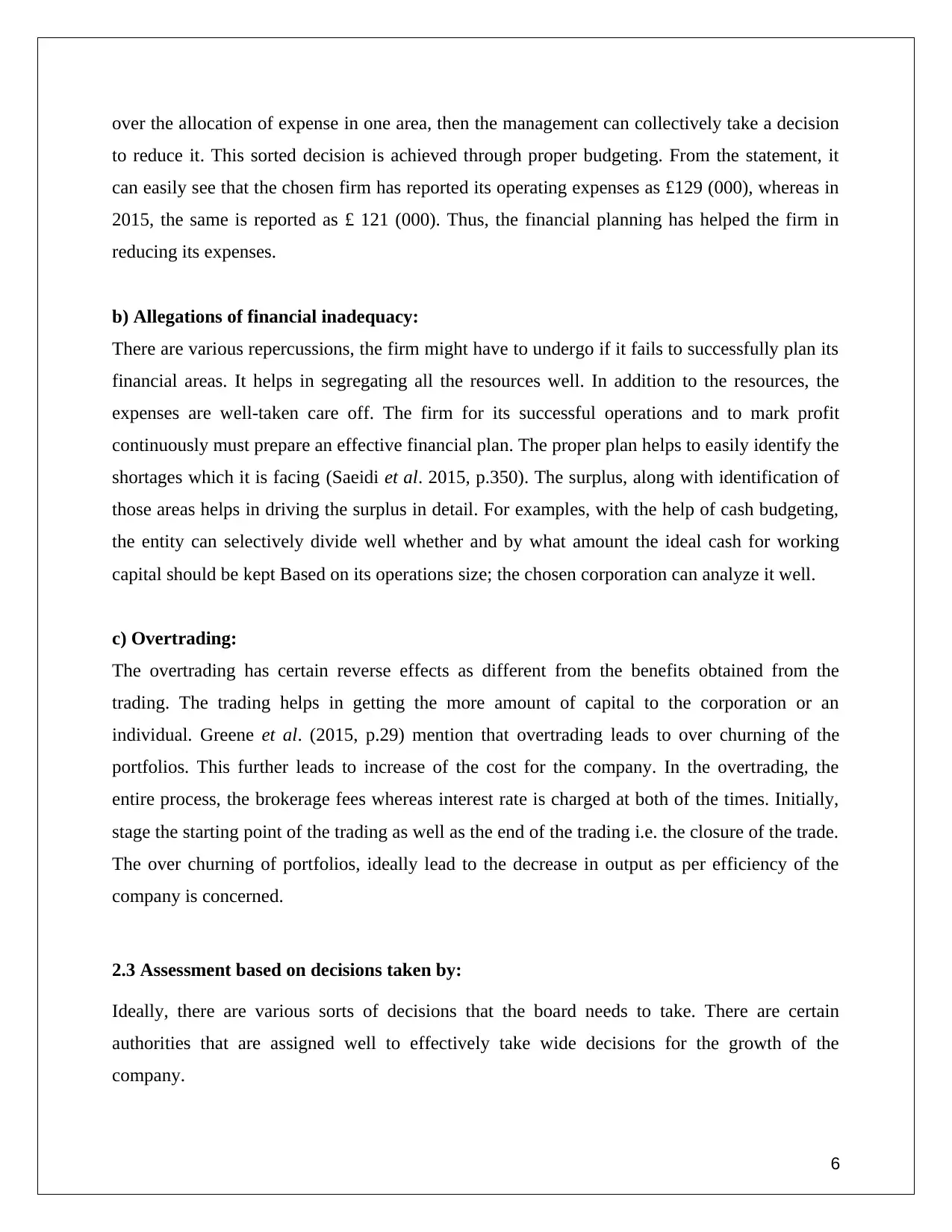
over the allocation of expense in one area, then the management can collectively take a decision
to reduce it. This sorted decision is achieved through proper budgeting. From the statement, it
can easily see that the chosen firm has reported its operating expenses as £129 (000), whereas in
2015, the same is reported as £ 121 (000). Thus, the financial planning has helped the firm in
reducing its expenses.
b) Allegations of financial inadequacy:
There are various repercussions, the firm might have to undergo if it fails to successfully plan its
financial areas. It helps in segregating all the resources well. In addition to the resources, the
expenses are well-taken care off. The firm for its successful operations and to mark profit
continuously must prepare an effective financial plan. The proper plan helps to easily identify the
shortages which it is facing (Saeidi et al. 2015, p.350). The surplus, along with identification of
those areas helps in driving the surplus in detail. For examples, with the help of cash budgeting,
the entity can selectively divide well whether and by what amount the ideal cash for working
capital should be kept Based on its operations size; the chosen corporation can analyze it well.
c) Overtrading:
The overtrading has certain reverse effects as different from the benefits obtained from the
trading. The trading helps in getting the more amount of capital to the corporation or an
individual. Greene et al. (2015, p.29) mention that overtrading leads to over churning of the
portfolios. This further leads to increase of the cost for the company. In the overtrading, the
entire process, the brokerage fees whereas interest rate is charged at both of the times. Initially,
stage the starting point of the trading as well as the end of the trading i.e. the closure of the trade.
The over churning of portfolios, ideally lead to the decrease in output as per efficiency of the
company is concerned.
2.3 Assessment based on decisions taken by:
Ideally, there are various sorts of decisions that the board needs to take. There are certain
authorities that are assigned well to effectively take wide decisions for the growth of the
company.
6
to reduce it. This sorted decision is achieved through proper budgeting. From the statement, it
can easily see that the chosen firm has reported its operating expenses as £129 (000), whereas in
2015, the same is reported as £ 121 (000). Thus, the financial planning has helped the firm in
reducing its expenses.
b) Allegations of financial inadequacy:
There are various repercussions, the firm might have to undergo if it fails to successfully plan its
financial areas. It helps in segregating all the resources well. In addition to the resources, the
expenses are well-taken care off. The firm for its successful operations and to mark profit
continuously must prepare an effective financial plan. The proper plan helps to easily identify the
shortages which it is facing (Saeidi et al. 2015, p.350). The surplus, along with identification of
those areas helps in driving the surplus in detail. For examples, with the help of cash budgeting,
the entity can selectively divide well whether and by what amount the ideal cash for working
capital should be kept Based on its operations size; the chosen corporation can analyze it well.
c) Overtrading:
The overtrading has certain reverse effects as different from the benefits obtained from the
trading. The trading helps in getting the more amount of capital to the corporation or an
individual. Greene et al. (2015, p.29) mention that overtrading leads to over churning of the
portfolios. This further leads to increase of the cost for the company. In the overtrading, the
entire process, the brokerage fees whereas interest rate is charged at both of the times. Initially,
stage the starting point of the trading as well as the end of the trading i.e. the closure of the trade.
The over churning of portfolios, ideally lead to the decrease in output as per efficiency of the
company is concerned.
2.3 Assessment based on decisions taken by:
Ideally, there are various sorts of decisions that the board needs to take. There are certain
authorities that are assigned well to effectively take wide decisions for the growth of the
company.
6
⊘ This is a preview!⊘
Do you want full access?
Subscribe today to unlock all pages.

Trusted by 1+ million students worldwide
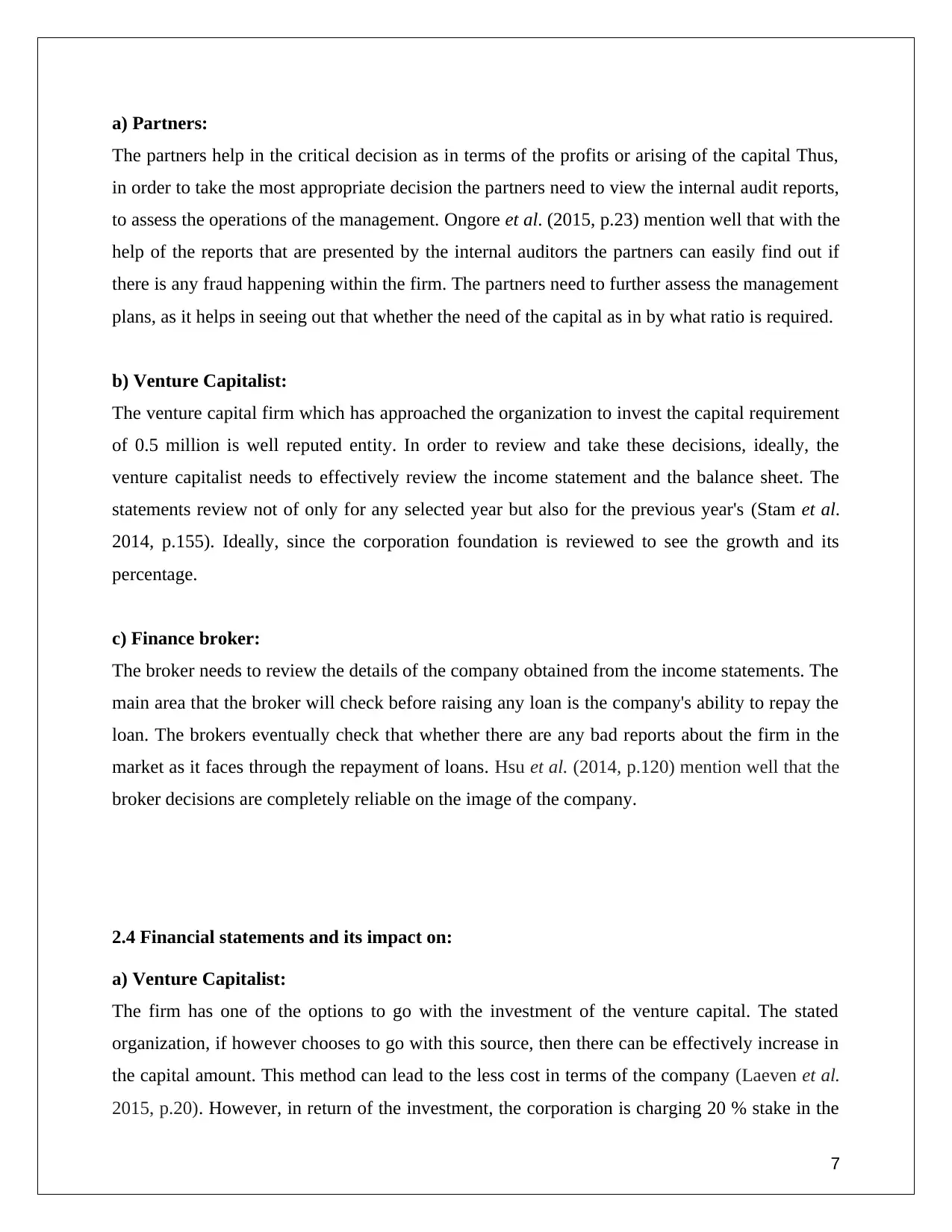
a) Partners:
The partners help in the critical decision as in terms of the profits or arising of the capital Thus,
in order to take the most appropriate decision the partners need to view the internal audit reports,
to assess the operations of the management. Ongore et al. (2015, p.23) mention well that with the
help of the reports that are presented by the internal auditors the partners can easily find out if
there is any fraud happening within the firm. The partners need to further assess the management
plans, as it helps in seeing out that whether the need of the capital as in by what ratio is required.
b) Venture Capitalist:
The venture capital firm which has approached the organization to invest the capital requirement
of 0.5 million is well reputed entity. In order to review and take these decisions, ideally, the
venture capitalist needs to effectively review the income statement and the balance sheet. The
statements review not of only for any selected year but also for the previous year's (Stam et al.
2014, p.155). Ideally, since the corporation foundation is reviewed to see the growth and its
percentage.
c) Finance broker:
The broker needs to review the details of the company obtained from the income statements. The
main area that the broker will check before raising any loan is the company's ability to repay the
loan. The brokers eventually check that whether there are any bad reports about the firm in the
market as it faces through the repayment of loans. Hsu et al. (2014, p.120) mention well that the
broker decisions are completely reliable on the image of the company.
2.4 Financial statements and its impact on:
a) Venture Capitalist:
The firm has one of the options to go with the investment of the venture capital. The stated
organization, if however chooses to go with this source, then there can be effectively increase in
the capital amount. This method can lead to the less cost in terms of the company (Laeven et al.
2015, p.20). However, in return of the investment, the corporation is charging 20 % stake in the
7
The partners help in the critical decision as in terms of the profits or arising of the capital Thus,
in order to take the most appropriate decision the partners need to view the internal audit reports,
to assess the operations of the management. Ongore et al. (2015, p.23) mention well that with the
help of the reports that are presented by the internal auditors the partners can easily find out if
there is any fraud happening within the firm. The partners need to further assess the management
plans, as it helps in seeing out that whether the need of the capital as in by what ratio is required.
b) Venture Capitalist:
The venture capital firm which has approached the organization to invest the capital requirement
of 0.5 million is well reputed entity. In order to review and take these decisions, ideally, the
venture capitalist needs to effectively review the income statement and the balance sheet. The
statements review not of only for any selected year but also for the previous year's (Stam et al.
2014, p.155). Ideally, since the corporation foundation is reviewed to see the growth and its
percentage.
c) Finance broker:
The broker needs to review the details of the company obtained from the income statements. The
main area that the broker will check before raising any loan is the company's ability to repay the
loan. The brokers eventually check that whether there are any bad reports about the firm in the
market as it faces through the repayment of loans. Hsu et al. (2014, p.120) mention well that the
broker decisions are completely reliable on the image of the company.
2.4 Financial statements and its impact on:
a) Venture Capitalist:
The firm has one of the options to go with the investment of the venture capital. The stated
organization, if however chooses to go with this source, then there can be effectively increase in
the capital amount. This method can lead to the less cost in terms of the company (Laeven et al.
2015, p.20). However, in return of the investment, the corporation is charging 20 % stake in the
7
Paraphrase This Document
Need a fresh take? Get an instant paraphrase of this document with our AI Paraphraser
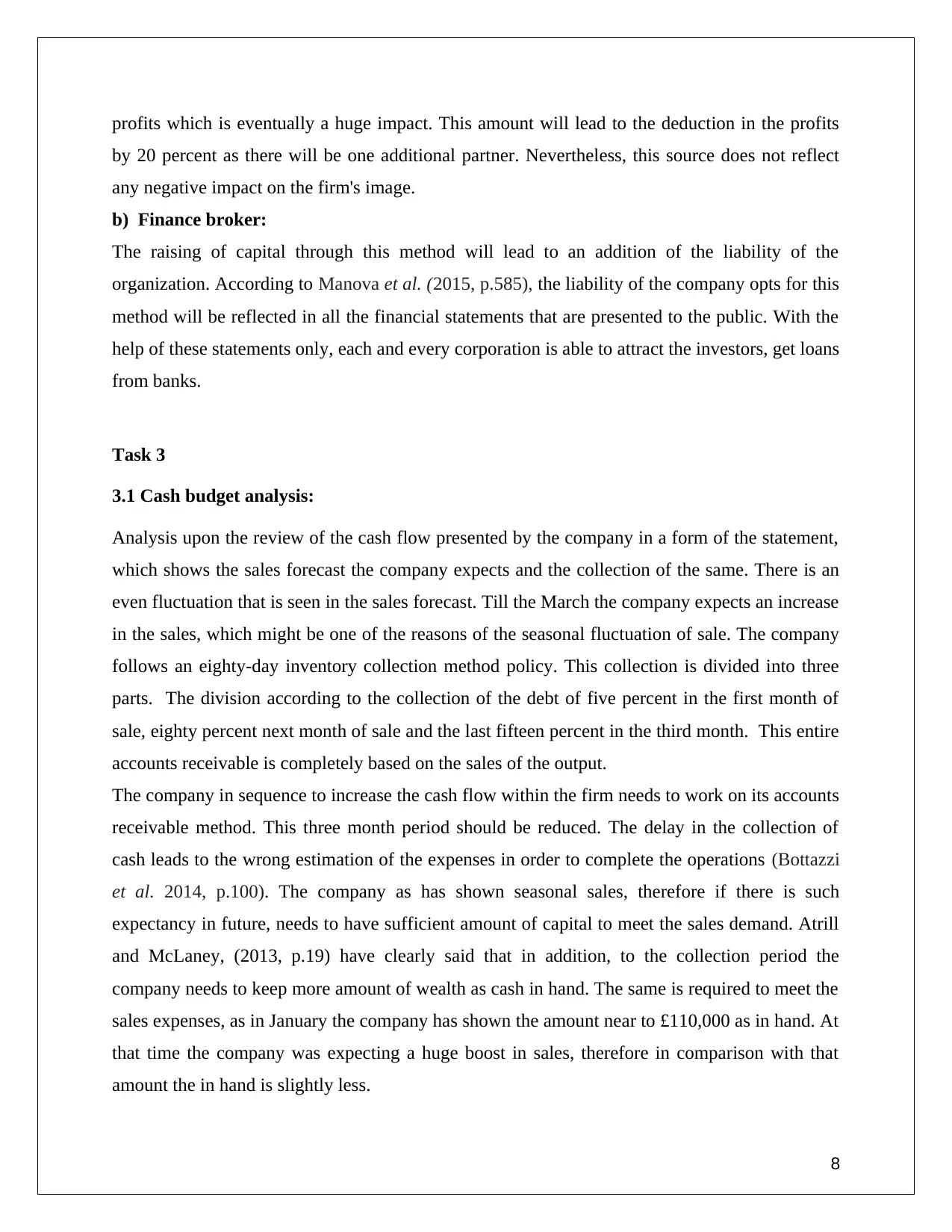
profits which is eventually a huge impact. This amount will lead to the deduction in the profits
by 20 percent as there will be one additional partner. Nevertheless, this source does not reflect
any negative impact on the firm's image.
b) Finance broker:
The raising of capital through this method will lead to an addition of the liability of the
organization. According to Manova et al. (2015, p.585), the liability of the company opts for this
method will be reflected in all the financial statements that are presented to the public. With the
help of these statements only, each and every corporation is able to attract the investors, get loans
from banks.
Task 3
3.1 Cash budget analysis:
Analysis upon the review of the cash flow presented by the company in a form of the statement,
which shows the sales forecast the company expects and the collection of the same. There is an
even fluctuation that is seen in the sales forecast. Till the March the company expects an increase
in the sales, which might be one of the reasons of the seasonal fluctuation of sale. The company
follows an eighty-day inventory collection method policy. This collection is divided into three
parts. The division according to the collection of the debt of five percent in the first month of
sale, eighty percent next month of sale and the last fifteen percent in the third month. This entire
accounts receivable is completely based on the sales of the output.
The company in sequence to increase the cash flow within the firm needs to work on its accounts
receivable method. This three month period should be reduced. The delay in the collection of
cash leads to the wrong estimation of the expenses in order to complete the operations (Bottazzi
et al. 2014, p.100). The company as has shown seasonal sales, therefore if there is such
expectancy in future, needs to have sufficient amount of capital to meet the sales demand. Atrill
and McLaney, (2013, p.19) have clearly said that in addition, to the collection period the
company needs to keep more amount of wealth as cash in hand. The same is required to meet the
sales expenses, as in January the company has shown the amount near to £110,000 as in hand. At
that time the company was expecting a huge boost in sales, therefore in comparison with that
amount the in hand is slightly less.
8
by 20 percent as there will be one additional partner. Nevertheless, this source does not reflect
any negative impact on the firm's image.
b) Finance broker:
The raising of capital through this method will lead to an addition of the liability of the
organization. According to Manova et al. (2015, p.585), the liability of the company opts for this
method will be reflected in all the financial statements that are presented to the public. With the
help of these statements only, each and every corporation is able to attract the investors, get loans
from banks.
Task 3
3.1 Cash budget analysis:
Analysis upon the review of the cash flow presented by the company in a form of the statement,
which shows the sales forecast the company expects and the collection of the same. There is an
even fluctuation that is seen in the sales forecast. Till the March the company expects an increase
in the sales, which might be one of the reasons of the seasonal fluctuation of sale. The company
follows an eighty-day inventory collection method policy. This collection is divided into three
parts. The division according to the collection of the debt of five percent in the first month of
sale, eighty percent next month of sale and the last fifteen percent in the third month. This entire
accounts receivable is completely based on the sales of the output.
The company in sequence to increase the cash flow within the firm needs to work on its accounts
receivable method. This three month period should be reduced. The delay in the collection of
cash leads to the wrong estimation of the expenses in order to complete the operations (Bottazzi
et al. 2014, p.100). The company as has shown seasonal sales, therefore if there is such
expectancy in future, needs to have sufficient amount of capital to meet the sales demand. Atrill
and McLaney, (2013, p.19) have clearly said that in addition, to the collection period the
company needs to keep more amount of wealth as cash in hand. The same is required to meet the
sales expenses, as in January the company has shown the amount near to £110,000 as in hand. At
that time the company was expecting a huge boost in sales, therefore in comparison with that
amount the in hand is slightly less.
8
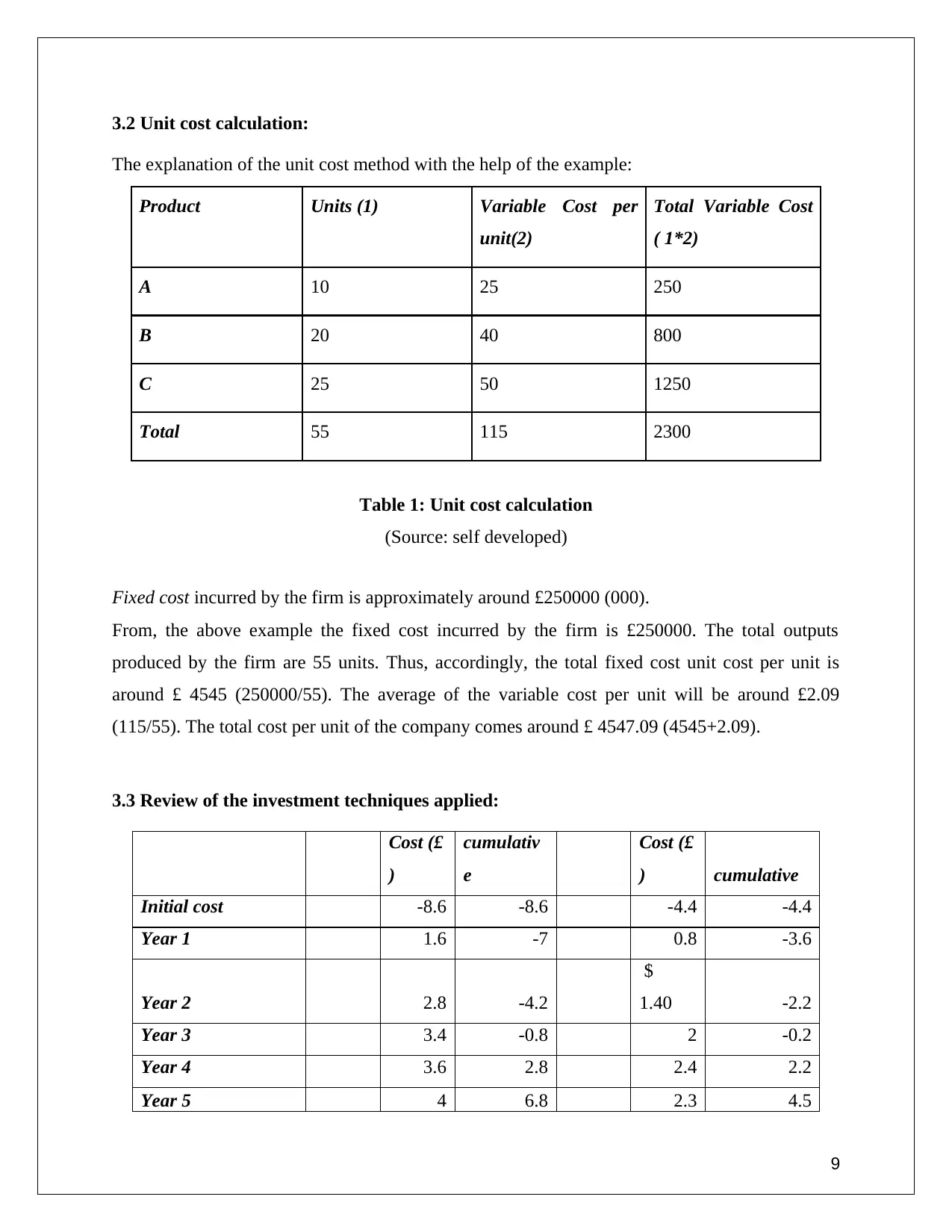
3.2 Unit cost calculation:
The explanation of the unit cost method with the help of the example:
Product Units (1) Variable Cost per
unit(2)
Total Variable Cost
( 1*2)
A 10 25 250
B 20 40 800
C 25 50 1250
Total 55 115 2300
Table 1: Unit cost calculation
(Source: self developed)
Fixed cost incurred by the firm is approximately around £250000 (000).
From, the above example the fixed cost incurred by the firm is £250000. The total outputs
produced by the firm are 55 units. Thus, accordingly, the total fixed cost unit cost per unit is
around £ 4545 (250000/55). The average of the variable cost per unit will be around £2.09
(115/55). The total cost per unit of the company comes around £ 4547.09 (4545+2.09).
3.3 Review of the investment techniques applied:
Cost (£
)
cumulativ
e
Cost (£
) cumulative
Initial cost -8.6 -8.6 -4.4 -4.4
Year 1 1.6 -7 0.8 -3.6
Year 2 2.8 -4.2
$
1.40 -2.2
Year 3 3.4 -0.8 2 -0.2
Year 4 3.6 2.8 2.4 2.2
Year 5 4 6.8 2.3 4.5
9
The explanation of the unit cost method with the help of the example:
Product Units (1) Variable Cost per
unit(2)
Total Variable Cost
( 1*2)
A 10 25 250
B 20 40 800
C 25 50 1250
Total 55 115 2300
Table 1: Unit cost calculation
(Source: self developed)
Fixed cost incurred by the firm is approximately around £250000 (000).
From, the above example the fixed cost incurred by the firm is £250000. The total outputs
produced by the firm are 55 units. Thus, accordingly, the total fixed cost unit cost per unit is
around £ 4545 (250000/55). The average of the variable cost per unit will be around £2.09
(115/55). The total cost per unit of the company comes around £ 4547.09 (4545+2.09).
3.3 Review of the investment techniques applied:
Cost (£
)
cumulativ
e
Cost (£
) cumulative
Initial cost -8.6 -8.6 -4.4 -4.4
Year 1 1.6 -7 0.8 -3.6
Year 2 2.8 -4.2
$
1.40 -2.2
Year 3 3.4 -0.8 2 -0.2
Year 4 3.6 2.8 2.4 2.2
Year 5 4 6.8 2.3 4.5
9
⊘ This is a preview!⊘
Do you want full access?
Subscribe today to unlock all pages.

Trusted by 1+ million students worldwide
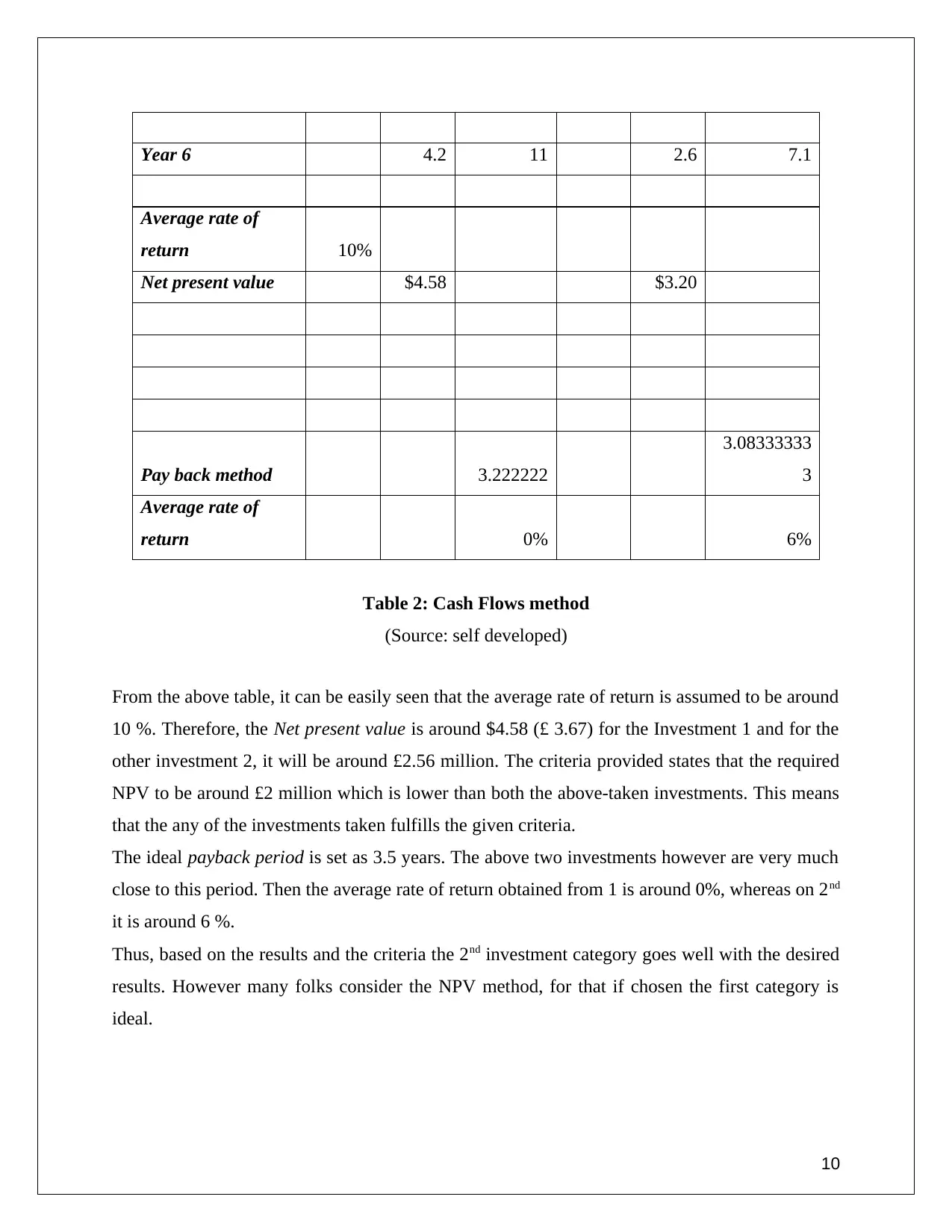
Year 6 4.2 11 2.6 7.1
Average rate of
return 10%
Net present value $4.58 $3.20
Pay back method 3.222222
3.08333333
3
Average rate of
return 0% 6%
Table 2: Cash Flows method
(Source: self developed)
From the above table, it can be easily seen that the average rate of return is assumed to be around
10 %. Therefore, the Net present value is around $4.58 (£ 3.67) for the Investment 1 and for the
other investment 2, it will be around £2.56 million. The criteria provided states that the required
NPV to be around £2 million which is lower than both the above-taken investments. This means
that the any of the investments taken fulfills the given criteria.
The ideal payback period is set as 3.5 years. The above two investments however are very much
close to this period. Then the average rate of return obtained from 1 is around 0%, whereas on 2nd
it is around 6 %.
Thus, based on the results and the criteria the 2nd investment category goes well with the desired
results. However many folks consider the NPV method, for that if chosen the first category is
ideal.
10
Average rate of
return 10%
Net present value $4.58 $3.20
Pay back method 3.222222
3.08333333
3
Average rate of
return 0% 6%
Table 2: Cash Flows method
(Source: self developed)
From the above table, it can be easily seen that the average rate of return is assumed to be around
10 %. Therefore, the Net present value is around $4.58 (£ 3.67) for the Investment 1 and for the
other investment 2, it will be around £2.56 million. The criteria provided states that the required
NPV to be around £2 million which is lower than both the above-taken investments. This means
that the any of the investments taken fulfills the given criteria.
The ideal payback period is set as 3.5 years. The above two investments however are very much
close to this period. Then the average rate of return obtained from 1 is around 0%, whereas on 2nd
it is around 6 %.
Thus, based on the results and the criteria the 2nd investment category goes well with the desired
results. However many folks consider the NPV method, for that if chosen the first category is
ideal.
10
Paraphrase This Document
Need a fresh take? Get an instant paraphrase of this document with our AI Paraphraser
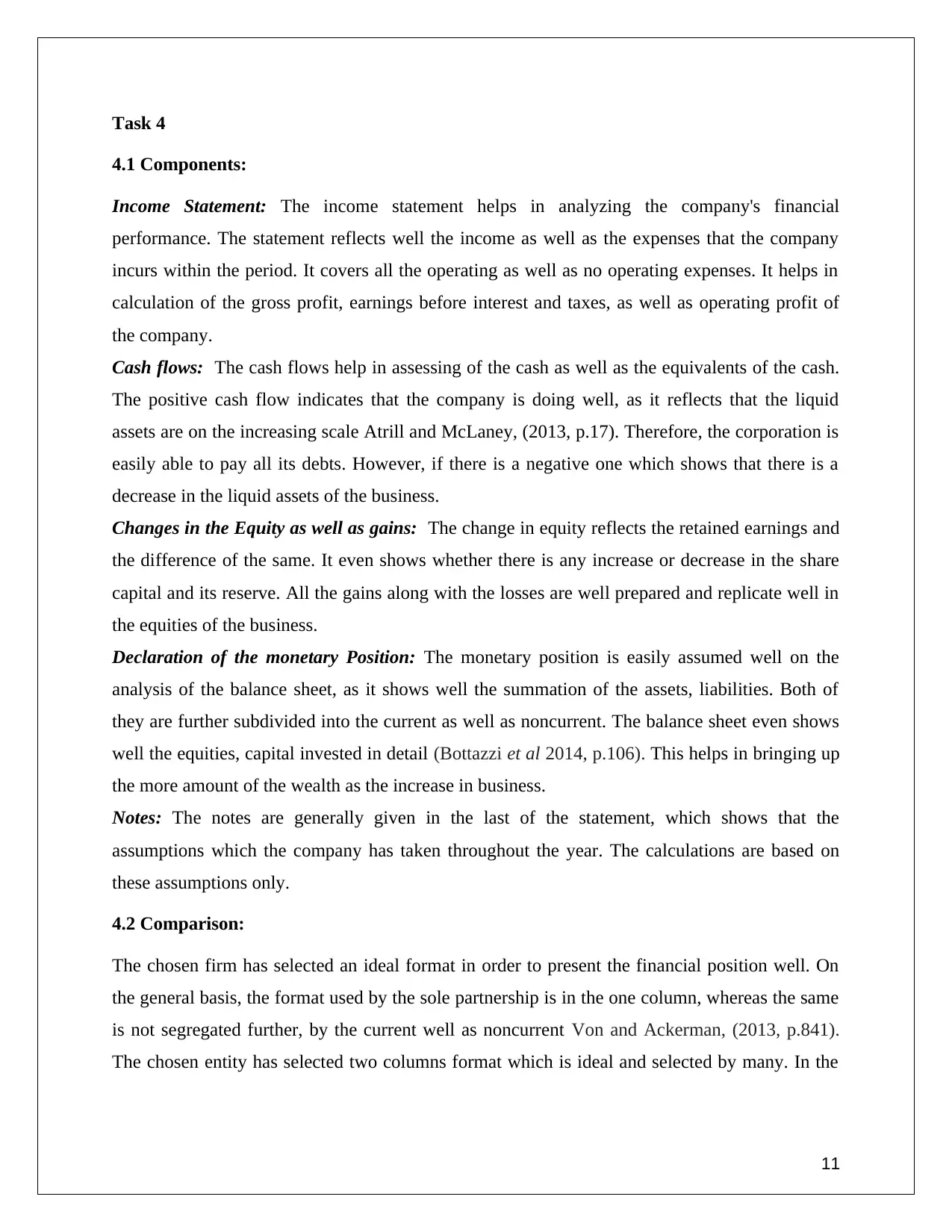
Task 4
4.1 Components:
Income Statement: The income statement helps in analyzing the company's financial
performance. The statement reflects well the income as well as the expenses that the company
incurs within the period. It covers all the operating as well as no operating expenses. It helps in
calculation of the gross profit, earnings before interest and taxes, as well as operating profit of
the company.
Cash flows: The cash flows help in assessing of the cash as well as the equivalents of the cash.
The positive cash flow indicates that the company is doing well, as it reflects that the liquid
assets are on the increasing scale Atrill and McLaney, (2013, p.17). Therefore, the corporation is
easily able to pay all its debts. However, if there is a negative one which shows that there is a
decrease in the liquid assets of the business.
Changes in the Equity as well as gains: The change in equity reflects the retained earnings and
the difference of the same. It even shows whether there is any increase or decrease in the share
capital and its reserve. All the gains along with the losses are well prepared and replicate well in
the equities of the business.
Declaration of the monetary Position: The monetary position is easily assumed well on the
analysis of the balance sheet, as it shows well the summation of the assets, liabilities. Both of
they are further subdivided into the current as well as noncurrent. The balance sheet even shows
well the equities, capital invested in detail (Bottazzi et al 2014, p.106). This helps in bringing up
the more amount of the wealth as the increase in business.
Notes: The notes are generally given in the last of the statement, which shows that the
assumptions which the company has taken throughout the year. The calculations are based on
these assumptions only.
4.2 Comparison:
The chosen firm has selected an ideal format in order to present the financial position well. On
the general basis, the format used by the sole partnership is in the one column, whereas the same
is not segregated further, by the current well as noncurrent Von and Ackerman, (2013, p.841).
The chosen entity has selected two columns format which is ideal and selected by many. In the
11
4.1 Components:
Income Statement: The income statement helps in analyzing the company's financial
performance. The statement reflects well the income as well as the expenses that the company
incurs within the period. It covers all the operating as well as no operating expenses. It helps in
calculation of the gross profit, earnings before interest and taxes, as well as operating profit of
the company.
Cash flows: The cash flows help in assessing of the cash as well as the equivalents of the cash.
The positive cash flow indicates that the company is doing well, as it reflects that the liquid
assets are on the increasing scale Atrill and McLaney, (2013, p.17). Therefore, the corporation is
easily able to pay all its debts. However, if there is a negative one which shows that there is a
decrease in the liquid assets of the business.
Changes in the Equity as well as gains: The change in equity reflects the retained earnings and
the difference of the same. It even shows whether there is any increase or decrease in the share
capital and its reserve. All the gains along with the losses are well prepared and replicate well in
the equities of the business.
Declaration of the monetary Position: The monetary position is easily assumed well on the
analysis of the balance sheet, as it shows well the summation of the assets, liabilities. Both of
they are further subdivided into the current as well as noncurrent. The balance sheet even shows
well the equities, capital invested in detail (Bottazzi et al 2014, p.106). This helps in bringing up
the more amount of the wealth as the increase in business.
Notes: The notes are generally given in the last of the statement, which shows that the
assumptions which the company has taken throughout the year. The calculations are based on
these assumptions only.
4.2 Comparison:
The chosen firm has selected an ideal format in order to present the financial position well. On
the general basis, the format used by the sole partnership is in the one column, whereas the same
is not segregated further, by the current well as noncurrent Von and Ackerman, (2013, p.841).
The chosen entity has selected two columns format which is ideal and selected by many. In the
11
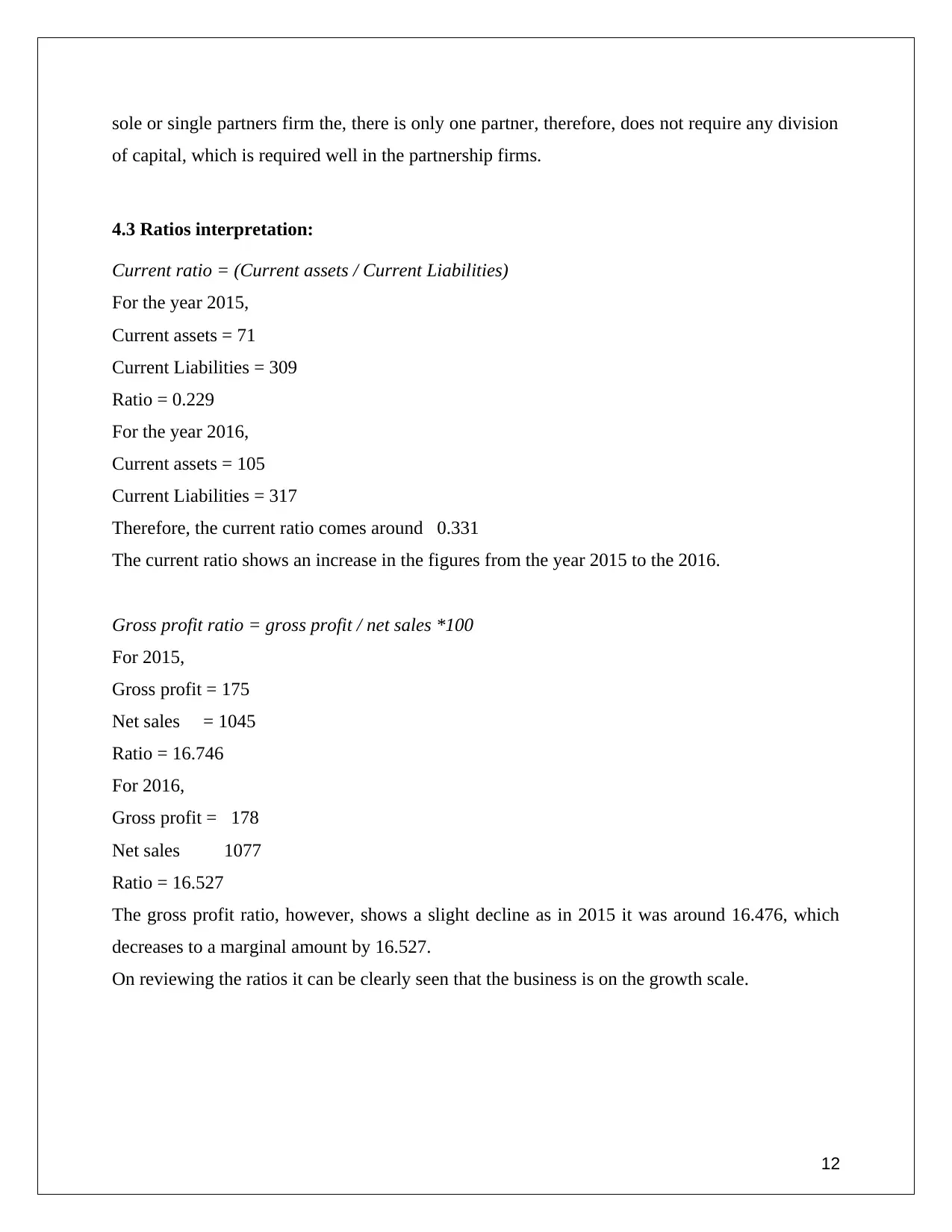
sole or single partners firm the, there is only one partner, therefore, does not require any division
of capital, which is required well in the partnership firms.
4.3 Ratios interpretation:
Current ratio = (Current assets / Current Liabilities)
For the year 2015,
Current assets = 71
Current Liabilities = 309
Ratio = 0.229
For the year 2016,
Current assets = 105
Current Liabilities = 317
Therefore, the current ratio comes around 0.331
The current ratio shows an increase in the figures from the year 2015 to the 2016.
Gross profit ratio = gross profit / net sales *100
For 2015,
Gross profit = 175
Net sales = 1045
Ratio = 16.746
For 2016,
Gross profit = 178
Net sales 1077
Ratio = 16.527
The gross profit ratio, however, shows a slight decline as in 2015 it was around 16.476, which
decreases to a marginal amount by 16.527.
On reviewing the ratios it can be clearly seen that the business is on the growth scale.
12
of capital, which is required well in the partnership firms.
4.3 Ratios interpretation:
Current ratio = (Current assets / Current Liabilities)
For the year 2015,
Current assets = 71
Current Liabilities = 309
Ratio = 0.229
For the year 2016,
Current assets = 105
Current Liabilities = 317
Therefore, the current ratio comes around 0.331
The current ratio shows an increase in the figures from the year 2015 to the 2016.
Gross profit ratio = gross profit / net sales *100
For 2015,
Gross profit = 175
Net sales = 1045
Ratio = 16.746
For 2016,
Gross profit = 178
Net sales 1077
Ratio = 16.527
The gross profit ratio, however, shows a slight decline as in 2015 it was around 16.476, which
decreases to a marginal amount by 16.527.
On reviewing the ratios it can be clearly seen that the business is on the growth scale.
12
⊘ This is a preview!⊘
Do you want full access?
Subscribe today to unlock all pages.

Trusted by 1+ million students worldwide
1 out of 15
Related Documents
Your All-in-One AI-Powered Toolkit for Academic Success.
+13062052269
info@desklib.com
Available 24*7 on WhatsApp / Email
![[object Object]](/_next/static/media/star-bottom.7253800d.svg)
Unlock your academic potential
Copyright © 2020–2025 A2Z Services. All Rights Reserved. Developed and managed by ZUCOL.





